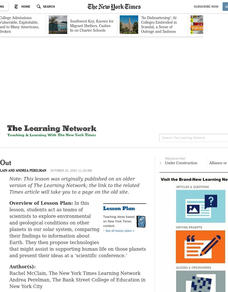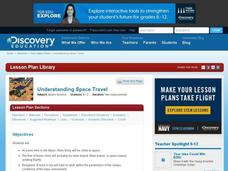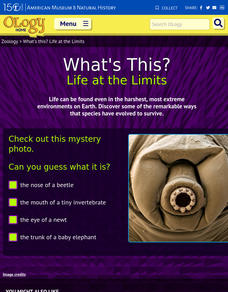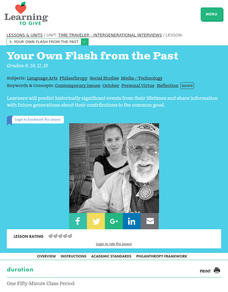Curated OER
Spacing Out
Young scholars explore environmental and geological conditions on other planets in our solar system, comparing their findings to information about Earth. They propose technologies that might assist in supporting human life on those planets.
Curated OER
Understanding Space Travel
Students study the unique environment of the moon and Mars. For this space science lesson, students design a city located in the outer space. They create a computer aided design, models or drawings of their cities and share them with the...
NASA
Let's Investigate Mars
Take your science class on a hypothetical field trip to Mars with an engaging astronomy lesson. After first learning about NASA's Mars rover missions, young scientists plan their own scientific investigations of Earth's...
Curated OER
The Planet Earth
Students explore the planet Earth, outer space, and Earth's axis. They demonstrate reading comprehension skills, including literal meaning, inference and critical analysis.
Curated OER
Working on the Moon
Students take a mission to the moon. In this space science instructional activity, students visit selected websites to discover information about Earth's moon and the solar system. Students may take virtual missions to the moon...
Curated OER
A Visitor from Outer Space
Young scholars read the handout, "A Visitor from Outer Space" and discuss the bill of rights. They complete the Bill of Right checklist individually or in small groups then complete a poll ranking each freedom. Students write reasoning...
Curated OER
E.T., Are You Out There?
Research the necessary components of a planet that supports life after reading the article "All of a Sudden, The Neighborhood Looks a Lot Friendlier" from The New York Times. After finding their information, middle and high schoolers...
Curated OER
My Alien
Young scholars listen to text read from "Hello! Anybody Out There?" and then brainstorm what aliens from outer space look like and do they exist at all.
They then will describe the physical features and a special ability or quality of...
American Museum of Natural History
What's This? Life at the Limits
There are some amazing ways species evolve to survive. From large ears to sneezing salt, learners read about these interesting adaptations in an interactive lesson. Great to supplement an in-class lesson, it also works well as a remote...
Curated OER
Science Fiction Stories
Learners write a story. In this genre lesson, students read a science fiction story and discuss its characteristics. Learners brainstorm a list of things that if scientifically changed would alter the way we live our lives. Students...
Curated OER
The Ancient World Explorer
Middle schoolers investigate the ancient structures of Mesopotamia, Egypt, India, and China. In small groups, they conduct research, evaluate their findings within the group, create visual aides, and complete an Internet treasure hunt.
Curated OER
How Does the Moon Affect Tidal Range?
Eighth graders study the phases of the moon. In this tides lesson students use the Internet to retrieve information.
Curated OER
Pilkey Author Study
Third graders read and hear stories by the author, Dav Pilkey and research the list of books written by this author. They become illustrators to the novel "Captain Underpants: An Epic Novel," then they create a timeline of their lives...
Curated OER
Diatom Ooze
Learners explore seafloor sediment. In this ocean environment instructional activity, students describe the characteristics of different types of seafloor sediment and oozes. They compare and discuss locations of sediments and oozes by...
Curated OER
Your Own Flash From the Past
High schoolers identify what they believe to be historically significant events in their lifetime. They write a letter to their future grandchildren about the event and how it effected the common good. They may read their letter to the...














